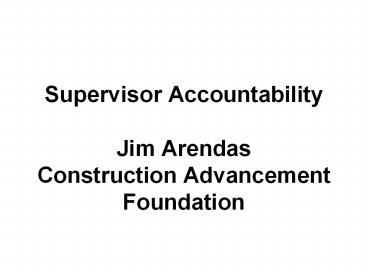Supervisor Accountability Jim Arendas Construction Advancement Foundation - PowerPoint PPT Presentation
1 / 18
Title: Supervisor Accountability Jim Arendas Construction Advancement Foundation
1
Supervisor AccountabilityJim
ArendasConstruction Advancement Foundation
2
Levels of Responsibility
- Executive Management
- High level commitment lower accident rates
- (Cheyne et al., 1998 Zohar, 1980)
- Supervision
- Work group encouragement and support
- (Donald, 1995).
- Worker
- Participation/ownership
- What motivates workers to take responsibility?
- (Lee, 1995)
3
OSHA Elements of Management Duty
- Establish policies, procedures and rules
- Safety Training
- Providing the right tool and equipment
- Enforcing the rules
4
Supervisory Challenges
- Characteristics of the work (Physical Hazards)
- Psychological and behavioral characteristics of
the individual - Organizational environments (Culture)
- (Cheyne, 2002)
5
Competing Organizational Influences
- Organizational values
- Short-term profits
- Customer needs
- Organizational Culture
6
Organizational Culture
Ela Oney-Yazici, Heyecan Giritli, Gulfer
Topcu-Oraz, Emrah Acar, (2007) "Organizational
culture the case of Turkish construction
industry", Engineering, Construction and
Architectural Management, Vol. 14 Iss 6, pp.519
- 531
7
Safety Culture?
8
Management Commitment
- Management Resources
- Leadership from Executive Management
- Time
- Involvement
- Support
- Evaluation
- Leading Indicators
- Measure positive behaviors
- Measure coaching and correcting
- Close calls
- Root cause of negative behaviors
- Measure history not TRIR
- Employee surveys
- Lagging Indicators
- Enforcement
- Throughout all levels of management and
supervision - The food chain
- Recognition
9
Worker Duty
- Not required by OSHA
- Duty to employer
- Follow rules or get wacked
- Duty to self is a personal choice
10
Relational Leadership Support
- Leader-member exchange
- Leaders have limited time
- Cross organizational support
- Relational support from supervisor
- Self-developed relational support
- Culture supported relational support
- No relational support
- (Uhl-Bean, 2006)
11
Team Dysfunctions of Safety Leadership
- Absence of Trust
- Absence of Conflict
- Lack of Commitment
- Avoidance of Accountability
- Inattention to Results
- (Lencioni, 2002)
12
Evaluating Safety Culture Maturity (RSSB UK)
- Level 1 Emerging
- Level 2 Managing
- Level 3 Involving
- Level 4 Cooperating
- Level 5 Continually Improving
13
Level 1 Emerging
- Safety is focused on
- Technical
- Procedural
- Compliance
- Safety not a key business risk
- Safety department responsibly for safety
- Accidents seen as unavoidable
- Most front line staff not interested in
- Safety used as a lever on other issues
14
Level 2 Managing
- Safety recognized as a business risk
- Management devoted to accident prevention
- Safety focus is on rules, procedures and
engineering controls - Accidents seen as preventable
- Management believes most accidents are due to
behaviors of front-line staff - Measures performance with lagging indicators
- Incentives based on reducing loss time incidents
- Senior managers only become involved in health
and safety if accidents increase punishment
likely to be used - Accident rates are near the industry sector
average but tend to have more serious accidents
15
Level 3 Involving
- Accident rates are low, but have reached a
plateau - Organization realizes employee involvement is
essential for improvement. - Management recognize that a range of factors lead
to accidents such as management decisions. - Most front-line employees will work with
management to improve safety. - The majority of staff accept personal
responsibility for their own health and safety. - Safety performance is monitored and the data used
16
Level 4 Cooperating
- The majority of staff believe that health and
safety is important from both a moral
economic reasons - Management recognizes that a range of factors
lead to accidents and the root causes stem from
management decisions - Front-line staff accept responsibility for their
own and others health and safety - Employees are valued and treated fairly
- Organization proactive measures indicators to
prevent accidents - Organizations addresses healthy lifestyle and
non-workplace accidents
17
Level 5 Continually Improving
- Injury prevention is a core company value
- Organization has several years without a
recordable accident or high potential incident
but there is no feeling of complacency - Leading and lagging indicators used to monitor
performance but it is not performance driven it
has confidence in its safety processes - Organization strives to be better and finds
improved hazard control approaches - Employees believe safety is a critical aspect of
their job and accept that prevention of non-work
injuries is important - Company invests considerable effort in promoting
health and safety at home
18
References
- Cheyne, A., Cox, S., Oliver, A., Tomas, J. M.
(1998). Modelling safety climate in the
prediction of levels of safety activity. Work and
Stress, 12, 255-271. - http//ergonomie.com.au/our-services/safety-and-ma
nagement-systems/safety-culture/ - RSSB.UK.co
- Construction Industry Institute
- Donald, I. (1995). Safety attitudes as a basis
for promoting safety culture An example of an
intervention. In Work and well-being An agenda
for Europe conference, Nottingham, 7-9 December. - Ela Oney-Yazici, Heyecan Giritli, Gulfer
Topcu-Oraz, Emrah Acar, (2007) "Organizational
culture the case of Turkish construction
industry", Engineering, Construction and
Architectural Management, Vol. 14 Iss 6, pp.519
- 531 - Lee, T. R. (1995). The role of attitudes in the
safety culture and how to change them. In
Conference on Understanding Risk Perception
Offshore Management Centre, Robert Gordon
University, Aberdeen, 2 February. - Oliver, A., Cheyne, A., Jose, M. T., Cox, S.
(2002). The effects of organizational and
individual factors on occupational accidents.
Journal of Occupational and Organizational
Psychology, 75, 473-488. - Lencioni, P., (2002), The Five Dysfunctions of a
Team, A leadership Fable, Jossey-Bass, San
Francisco, CA. - Uhl-Bean, M., (2006). Relational leadership
theory exploring the social processes of
leadership. The Leadership Quarterly, 17(6),
654-676.































